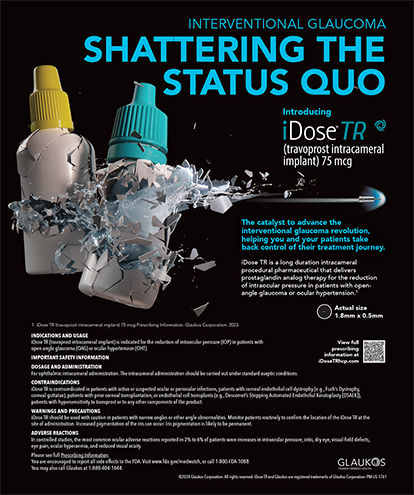

Skin care is usually provided by dermatologists. Individuals often turn to dermatologists for periocular skin care, because the average person thinks of ophthalmologists as medical providers for the eyes only. It never crosses people’s minds to approach their ophthalmologist about skin care, although the periocular skin is together with the globe of the eye. Educating the public is part of the ophthalmologist-patient relationship.
AT A GLANCE
• Ophthalmologists and oculoplastic surgeons study the skin of the periocular region and are well versed in working with this delicate area. The periocular skin not only protects the globe from external damage, but it also plays a significant role in the eye’s health.
• Skin’s permeability relates to the amount of lipids contained in its layers, not to its thickness. The periocular skin contains one-tenth the lipids of other areas of skin, making it 10 times more permeable to pathogens and organic and industrial pollutants.
• Keeping the skin around the eyes clean and healthy is crucial not only for a healthy and younger appearance but also for supporting the main purpose of the periocular skin, which is ocular protection and preservation of vision. Unhealthy eyelids, with inflammation of the glands and the hair follicles, can make eyes itch and blur vision, with a constant feeling of burning and pressure inside the eyes.
Ophthalmologists, and oculoplastic surgeons in particular, study the skin of the periocular region and are better versed in working with this delicate area both surgically and nonsurgically. Not every ophthalmologist will be comfortable recommending skin care treatments, but those who are should absolutely be trusted and inform their patients of their extensive knowledge in this area and the complexity of periocular skin treatment.
Why? Because the periocular skin is unique. Not only does it protect the globe from external damage, but it also plays a significant role in the eye’s health. The eyelids contain glands that are vital to tear composition, and they act as barriers against dryness of the conjunctiva and the cornea. A healthy tear film layer and ocular surface are important for the optical properties of the cornea, which ensures good vision. As a part of the lacrimal drainage system, the lids distribute the tear film on the cornea and drain excess tears along with debris from the ocular surface.
The actual skin of the eyelid is unique in several ways: it is among the thinnest areas of skin on the body, it lacks a subcutaneous layer, it is exposed to environmental factors, and it shows signs of aging very early. Also, the eyelids are in constant motion: they open and close thousands of times every day (11 to 15 times per minute) to maintain a healthy, wet ocular surface. This constant muscular movement transmits to the thin overlying skin and contributes to aging.
ANATOMY
The epidermis is made of four layers (the stratum corneum, the basal, the spiny, and the granular layers) that are 75 μm thick. The renewal of the epidermis is very fast, up to every 7 days versus up to 2 weeks in other areas of the body. The inner skin surface, the dermis, is made of loose connective tissue containing collagen, elastin, and reticulin, which, when damaged, becomes loose and wrinkled. The dermis also contains nerves, blood vessels, lymphatics, glands (sebaceous and sweat), and hair follicles. The dermis normally lies between the epidermis and a layer of subcutaneous fat. In the eyelids, the dermis lies between the epidermis and the orbicularis muscle, which provides less cushioning and thus makes the dermis more vulnerable to trauma.
CLEANLINESS AND HEALTH
The permeability of the skin is related to the amount of lipids contained in its layers, not to its thickness. The periocular skin contains one-tenth the lipids of other areas of skin, making it 10 times more permeable to pathogens and organic and industrial pollutants.
Keeping the skin around the eyes clean and healthy is crucial not only for a healthy and younger appearance but also for supporting the main purposes of the periocular skin, which are ocular protection and preservation of vision. Unhealthy eyelids with inflammed glands and hair follicles can make eyes itch and blur vision, with a constant feeling of burning and pressure inside the eyes.
Blepharitis and dry eye disease affect a large proportion of the population. Often, the roots of these conditions lie in unhealthy eyelid skin. To play its role as a barrier for the eyes, eyelid skin must remain hydrated. In contrast to thicker skin, which has more reserves and more layers, cracked eyelid skin greatly increases the risk of infection.
CONCLUSION
Ophthalmologists receive training not only on the pathology of the globe but also the pathology of the periocular skin. They can therefore play an important role in treatment of the eyelid skin and can be great resources for patients regarding skin care. It is important to educate patients that maintaining healthy eyelid skin through proper ophthalmologic care will have an impact on their eyes, making them not only look better but also see better. Eyelid skin care requires this extra attention, and ophthalmologists and oculoplastic surgeons are thoroughly trained to provide such care. n
Apostolos Anagnostopoulos, MD
• research fellow, oculofacial plastic & reconstructive surgery, orbit and oncology, Bascom Palmer Eye Institute, University of Miami Miller School of Medicine, Miami
• axa1753@miami.edu
Wendy W. Lee, MD • associate professor of clinical ophthalmology and dermatology, oculofacial plastic & reconstructive surgery, orbit and oncology, Bascom Palmer Eye Institute, University of Miami Miller School of Medicine, Miami
• (305) 326-6434; wlee@med.miami.edu


